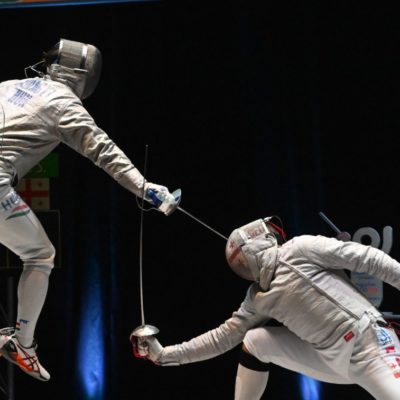“Turn off your mind, relax and float down stream […] Lay down all thoughts, surrender to the void. It is shining, it is shining. Yet you may see the meaning of within. It is being, it is being.”
-John Lennon, Tomorrow Never Knows
This weekend at the Pomme de Terre, I was squaring off against my old college teammate Kai-Moritz Keller, a German fencer harder to break through than the Berlin Wall. As the second period came to a close, I trailed 12-7. I walked to the end of my strip, closed my eyes, and began to meditate. I replayed all the touches in my mind, thinking what Kai had done to hit me, why I couldn’t get past his guard, and then envisioned the actions I was going to use to turn the bout around. Despite Kai being three touches away from victory, I could not accept the possibility of an imminent defeat.
I came out more confident, pressing around the guard, baiting his parries and sniping him under the wrist, going to his foot when he came in with his hand up, which I had visualized doing during the one minute break. The next thing I knew, I was up 14-13. But then I choked and lost (I said this post was about bringing it back, not finishing the bout). There are a few things that you can do to internalize bringing a bout back, which I’ve shared with you below:
- Never accept defeat until the final touch is scored– Epic comebacks are common in our sport; yet, far too often I see athletes who just roll over when they’re down three or four touches. The first step to regaining victory is to know that the victory is still attainable.
- If things aren’t going your way, try to run down the clock to collect your thoughts– Subtly look at the clock to get an idea of how much time is remaining in the period. Instead of trying something new, let the clock run down to mentally reset in between periods and devise new strategies. In boxing, you try to clinch your opponent if you’re seeing stars and are on the verge of getting knocked out. In fencing, you have the luxury of killing the clock.
- Know why you’re getting hit and have a plan B– You’re not always going to have a strip coach with you. This idea will come with experience, but you need to have an awareness of your bout and the tactics used by both you and your opponent. Why are you losing? What actions can you bring to the table to turn it around when your initial plan fails? Fencing requires you to think outside the box and be creative. Be aware of the bout in all of its components (distance, preparation, closing actions, etc.) and know which areas to tweak in order to win.
- Convince yourself the score is 0-0 every touch– If you go through a string of touches to recoup a deficit, you might lose sight of the fact that you were down a few to begin with, and confidence can turn into overconfidence (e.g. my 14-13 choking. Ugh.) Reset every single touch as if it is the beginning of a new bout. This is of course consistent with the idea of “one touch at a time.”
- Utilize some form of meditation to “get in the zone” during the one minute break- It can be flustering when things aren’t going your way in a bout, and there’s nothing like some form of basic meditation to get you to clear your mind. Close your eyes, inhale for three seconds, exhale for three seconds, and relax. A calm and clear mind is needed on the path to victory. Try to enter every period relaxed.
- Believe in yourself- If you believe you’ve lost when you’re losing, then you’re going to lose. But if you believe you can win when you’re losing, then the victory can still be yours. Confidence stems from experience and tournament preparation.
The more you compete, the more these ideas will become natural. The bout is not over until the final touch has been scored, so don’t believe anything but!






